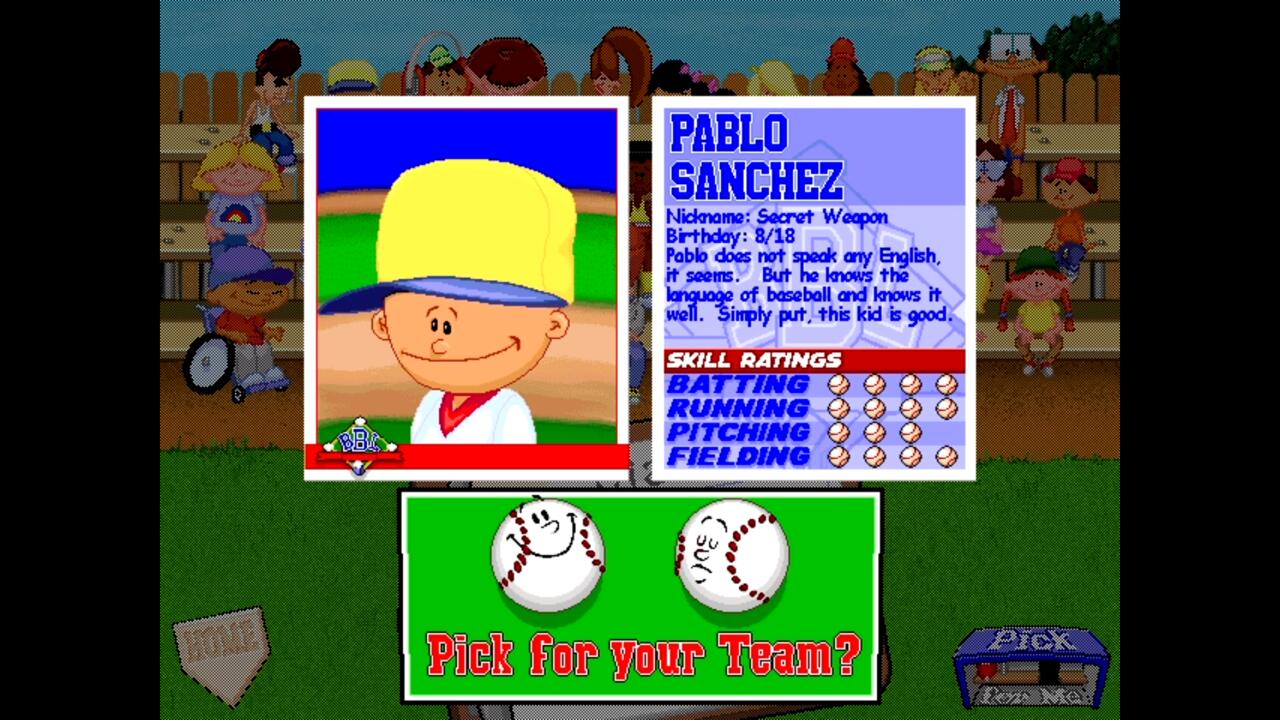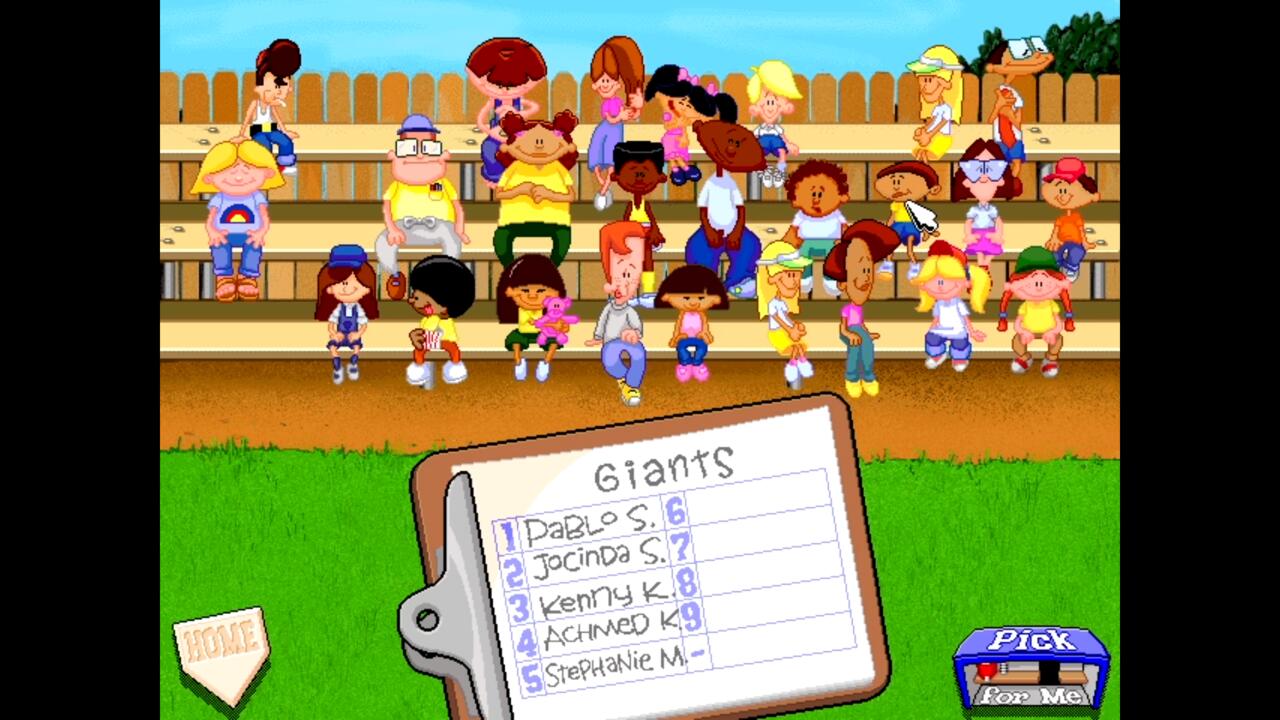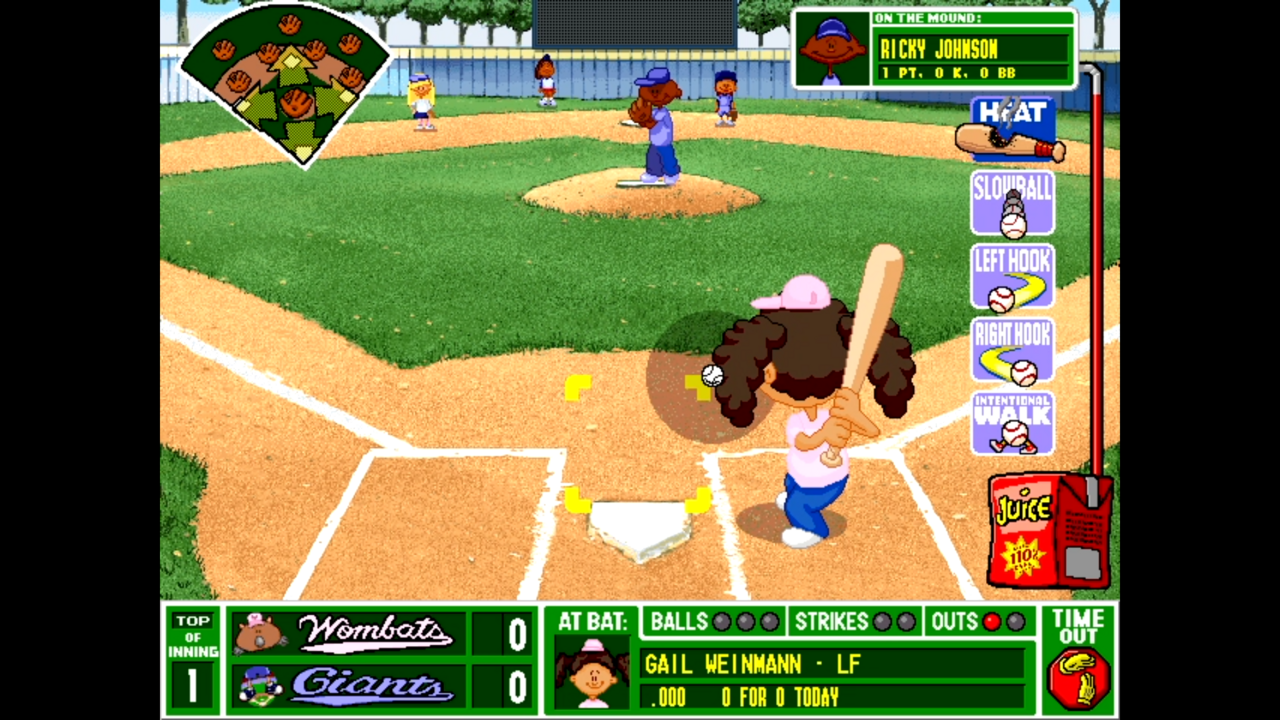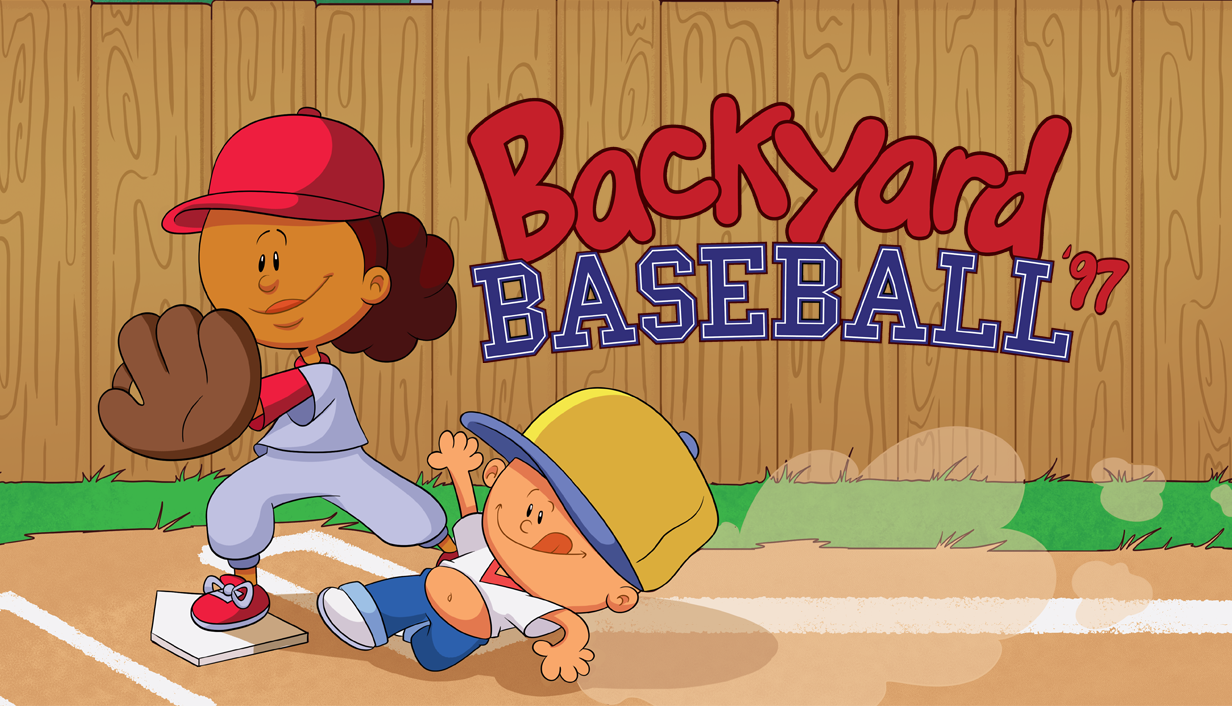It’s the bottom of the ninth in the fifth and final game of the Super Ultra Championship of the Universe Series. My Mighty Monsters are trailing by two runs and down to their final out. Kenny Kawaguchi, the league’s best pitcher coming off a record-setting season for strikeouts, is at the plate. No one would doubt his repertoire at the mound, but his strength has never been in the batter’s box. With runners on first and third, the count goes full–could it be any more dramatic? The 3-2 pitch screeches inside, but Kenny makes great contact. Incredibly, the ball is launched. The kid only had four homers all year, but this one could count for much more. It’s high enough if it’s got the velocity. Back, back, back… gone! The Monsters win! A walk-off three-run blast from the team’s pitcher sends the squad of neighborhood pals into the history books of the Backyard Baseball League. Do you believe in miracles?
My true story of sports heroics took place roughly 24 years ago on one of those colorful Mac computers many had in the late ’90s and early aughts. Backyard Baseball, once handed out merely as the prize inside a cereal box, would go on to become an institution in the lives of Millennial kids everywhere, and if you’re around my age, you might have some nostalgia for it yourself. Over a quarter-century since the game first debuted, Backyard Baseball ’97, as it’s now officially called, has debuted on Steam–where shady download links and eBay price gougers can’t hurt you. It’s been great to discover the game still holds up, even as it’s also very obvious that I am no longer the target audience.
Backyard Baseball ’97 is a re-release of the original game that kicked off the Backyard Sports series. Under new rights-holders, the plan is to bring back several games lost to time, eventually paving the way for a Backyard Sports multimedia universe. With such grand plans for the future, the first release of the bunch has thankfully turned out great, and could feasibly serve as the series’ grand re-opening. It’s said that the game is remastered, though I can’t see how. Every inch of it looks identical, not just to my spotty memory, but also when I compare it to gameplay videos online.
The colorful 2D sports game stars a roster of 30 diverse kids, each of them with their own attributes, voice acting, theme song, nickname, bio, and personality. It’s these kids, even more than the solid beginner-friendly baseball mechanics, that make Backyard Baseball timeless. You could poll any number of former fans, and every last one of them would be able to tell you about their favorite characters and the memories they have of them.
There’s Pete Wheeler, the not-so-bright speedster who can steal any base–provided he knows which way to run. There’s Keisha Phillips, a towering young girl with an affinity for telling jokes and hitting dingers. There’s the Webber twins, Sidney and Ashley, who come from the rich side of town but aren’t afraid to mix it up on the diamond with kids from other walks of life, so long as they’re on each other’s team. There’s Achmed Khan, a music-obsessed kid who plays every game with headphones on, and his little brother Amir, who looks up to Achmed in such an endearing, little-brother way.
Of course, the most unforgettable of them all is Pablo Sanchez, nicknamed The Secret Weapon. In reality, he’s sports’ worst-kept secret. There’s nothing he can’t do, and even as the games were hard to obtain in recent years, the legend of Pablo has been revisited many times, with real-life athletes paying tribute to him in different ways. Virtually every team starts with Pablo, but each and every one of the kids is well-written and feels like a fully realized character; they’re all charming in their own ways.
That focus on personality and leaning into the magic of childhood continues onto the various fields themselves. There are several different parks you’ll play at, each of them capturing the make-do spirit of neighborhood kids putting a team or league together. There’s Tin Can Alley, with its defense-friendly high walls and short outfield due to things like a dumpster and truck container getting in the way. Sandy Flats is played on a beach, with an outfield “wall” made from a windswept fence in the sand. A few of the kids’ own backyards are settings for games, like Ernie’s Steele Stadium, where homers land in the neighbor’s pool, and Kimmy’s Eckman Acres, complete with professional landscaping surely paid for by her parents.

Each setting feels like it could be the scene in a similarly styled cartoon, like Hey Arnold or Recess, and playing the games themselves continues this vibrant and youthful spirit. A commentary crew consisting of uber-professional Sunny Day and comically bookie-coded Vinny The Gooch talks you through each game, relating scoring plays to nabbing Halloween candy and commenting on the game’s special pitches, like a Slo-Mo ball that cartoonishly defies Newtonian physics.
Everything is recontextualized for a kid’s-eye-view of the world. Between at-bats that come to life with earworms in the form of walk-up theme songs, players also constantly chirp phrases at one another, such as, “We want a batter, not a broken ladder!” The field is never quiet, just like it in real life whenever a group of kids gets together. Each inning sounds like a sugar rush and looks like a weekend with friends. There’s magic in the air.
More than anything else, Backyard Baseball owes its timelessness to these qualities. It’s a colorful world that feels familiar and relatable but also presents a richly detailed alternate universe where every character is someone’s favorite and every game is fun to play. In 2024, Backyard Baseball ’97 remains overstuffed with personality. I used to speculate part of the reason these games disappeared is because in later sequels they began to seek out licenses from leagues and players’ unions, such as the MLB and MLBPA, which perhaps became prohibitively priced. Newer games included several pro players, like Randy Johnson and David Ortiz to help sell the game, and I thought maybe the creators saw this feature as non-negotiable. But I never cared for those players anyway; I always wanted the original Backyard kids. They’re the true stars of this series.
Solid baseball gameplay mechanics aid the memorable people and places of the game despite a novel control setup. Backyard Baseball uses point-and-click mechanics not unlike the other titles in the library belonging to the game’s original publisher, Humongous Entertainment. It may sound odd for a sports game, but it works well. Pitching and batting come down to placement and timing on both sides of that exchange, and different levels of on-screen help can make batting, in particular, easier to do, like pitch-locator UI elements that help you line up your swings better.
On the field, you simply click where you want your players to go, and the one nearest to where you’ve clicked will move there to meet the ball’s can’t-miss shadow, allowing you to perform feats like turning a double play or catching a fly ball. Players will tag up and try to score after you’ve caught a fly in the outfield, and though you can’t attempt baserunner pick-offs, staffing a solid catcher can mean the difference between preventing a stolen base or letting them slide safely into second.

Errors can still occur, so it’s important not to put a kid with lesser fielding attributes in a high-volume position like shortstop or center field, and by playing with your kids a lot, you may come to find where they best fit, after which point you can adjust their spot on the field or in the starting nine easily in the pause menu. I like having Pete and Pablo in the outfield because they’re so fast, while Stephanie Morgan basically demands to play shortstop–and that’s fine with me, since she’s great at it.
The game’s simple controls make learning easy for kids or anyone who doesn’t usually play games. I have fond memories of when I was younger and Backyard Baseball actually inspired my dad to make a team and play through a season too–and he’s essentially never played video games in his life.
However, given that I do play games and I’m no longer a kid playing this at the turn of the millennium, it’s clear that I’ve passed the game by in some important ways, too. It’s a children’s game, and a great one at that, but even on the game’s hardest settings–in which I’ve fully upped the difficulty, removed the pitch-locator tools, and have even consciously chosen to ignore power-ups like an aluminum bat that guarantees a home run, or a scorching fireball that is effectively too fast to hit, the game sadly doesn’t present a challenge anymore.
My first game was tough for a few innings, and up until the fourth inning, I had only five hits as a team in a scoreless game. But then my batters came alive and I ended up beating the CPU 22-0. Future games in my march toward championship glory unfolded similarly. It was like it took me a few at-bats to re-find my timing, and once I found it, the game’s stakes were sent to the dugout. As I began to apply self-imposed restrictions, score differentials were reduced, but I never felt threatened in a way that provided the compelling drama of my first championship a quarter-century ago.
This isn’t exactly a flaw of the game; it’s clearly designed for kids. However, in reviving the project, the team chose not to tweak anything despite knowing the nostalgic series would surely bring adult fans back. There’s a purity argument I’m sympathetic to in this case–game preservationists will enjoy that the game is identical to how it was before–but that means many won’t be challenged enough to stick around for long. In that case, such fans are almost better off waiting for Backyard Productions–the new rights holders with multimedia intentions–to bring the game’s awesome characters to life via a TV show or, perhaps, a totally new game with a higher difficulty bar for those who want it.
With only pick-up games and a season mode on offer, the game also seems to miss an opportunity to do things like add multiplayer, co-op, or other modes that modern technology allows. My hope is a modding community can spring from this re-launch, and perhaps the new studio behind the series is even banking on that, too.
A “remaster” of this game more in line with the usual meaning of the word feasibly would’ve included quality-of-life updates. Yet, Backyard Baseball ’97 seems not to have given any attention to that part of the game. One of its greatest exploits always was and remains an ability to fool CPU baserunners into advancing when they shouldn’t. For example, if a CPU baserunner safely hits a single, rather than throw the ball to the pitcher and invite the next batter into the box, you can simply throw the ball to another infielder or two. Before long, the CPU will misjudge this as an opportunity to advance, letting you easily catch them in a pickle.
You can do this as many times as you want to; you always could, and you still can in this new Steam version of the game. Much like the way I had to consciously opt out of using power-ups on offense or defense to make the game a bit harder for myself, players of all ages will have to find their own moral fiber and not resort to cheesing the CPU just because doing so might be convenient when trying to win a game. Not everyone knows this trick, but for those who discover it, it’s like returning a lost wallet to its owner; it falls on you to do what’s right.

Still, if that’s a parents-and-kids teaching moment waiting to happen, then it’s one of many this game offers, and that’s usually a great thing. The game is a fantastic experience for young players overall, and having their parents, siblings, or other loved ones right there beside them, perhaps teaching them video games, baseball, or both, feels like a setting conducive to new magic being conjured with this roster of diverse characters and the sports league they’re obsessed with.
I once enjoyed the game as a player, back when I was in the middle of the game’s target audience. Today, I’m well outside of that, but the game has taken on new meaning to me now that I have kids of my own. Because the core gameplay remains fun and easy to learn, passing down my favorite characters to my kids has been a heartwarming joy, and watching their favorites emerge has been exciting. I can’t really play this game competitively anymore; I’ve outgrown it in that sense. But I could never outgrow these vibrant kids that helped shape my childhood, and I’m confident other parents, whether they grew up with the game or not, will sense a similar magic when they play it with their kids, too.
